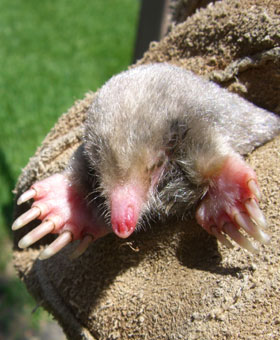Mole Removal and Control in Seattle
|
Coast Mole Biology: Also known as the Pacific Mole, this energetic little guy (about 6 inches long) can build up to 300 mounds (mole holes) in a single winter. They are active year-round, and mostly solitary, except when
searching for a mate. 2-4 young are born in the spring.
Townsend's Mole Biology: Scapanus townsendii is North America's largest mole, at about 9 inches in length. Behavior is similar to that of the Coast Mole.
Nuisance Concerns: Moles are common in the Puget Sound area. The primary nuisance concern is that they dig, and can damage landscaping. That's about it. They create a few different types of tunnels. The
surface feeder tunnels often snake out all across a lawn. They are created when a mole digs its way through the shallow dirt in search of food: earthworms, grubs, and other small invertebrates. Because a mole has
a high metabolism and is very active, it can create a lot of these surface ridges. People often complain about the appearance to the lawn, or say that the ground feels "squishy", a result of stepping on the loose,
raised tunnels. Moles also create deeper holes and chambers, and will often push large piles of dirt up to the surface of the lawn, and many people find these unsightly or damaging as well. |
|
 |

This is a professional wildlife removal company based in Seattle Washington. We provide pest control for wild animals only, not extermination of insects. If you have nuisance critters that you need to
get rid of, we can humanely take care of the problem.
What is a mole hill? Describe mole tunnels? A mole may seem to be a cute, small, safe animal, but trust us it can change the entire look of your garden within few days. If you think they canít do much damage think again. Many people have suffered and left devastated due to mole activities. They have seen their beautiful and lush garden turned into dead and dry place. Their flowers gone, their grass died. A mole digs tunnel under the surface, they can dig up to 100 feet. The digging results in uprooting of plants. Another common problem caused by these moles is the molehill.
Molehill is also known as mole mound. It is a pointed mount of loose soil and it is mostly caused by small burrowing mammals. These animals include voles, moles, marsupial and mole-rats. However, the moles are famous for causing these conical hills of loose soil. They might damage your garden but they also make you aware of the activities taking place beneath the surface of your garden, thus allowing you take action in time and save your garden.
We often come across the question that from where does the molehill come from? They come from digging waste material or when then animal is trying to repair its holes. Because of these reasons you will always find the molehill near the place where the animal is residing. Most of these molehills are near the shrubs or roots of trees. The root of trees supports the tunnel and helps it become less prominent. These holes are only present in the line around the route of the final hole but sometimes it happens that they occur at the end of short tunnels. Most of these holes are not that deep, but the tunnel that follows them is usually deep. Most of these run from 12 to 18 inches deep. The tunnels that lay beneath the molehills are very useful for moles as they are able to get their food such as earthworms through them. The animal digs deeper and deeper in order to catch its prey and once found, it comes back to the surface with the help of molehills.
However, the same molehills that can cause a chaos in your garden can also help in making your soil fine. The molehills are very important of some practicians of permaculture. Nevertheless, if you donít want the molehills to change the way your garden looks, you can always get the moles removed. There are different ways through which you can the mole or other animals that cause molehills removed. Also, if you want to determine the number of moles that are present around your house you need to count the number of molehills. These are the only way of determining the number of moles present around your area.
|